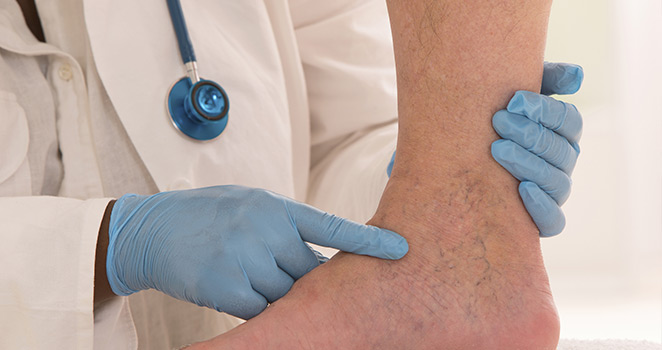Atrium Health Navicent Heart & Vascular Care
VNUS Closure® Procedure for Varicose Veins

Varicose veins are enlarged tortuous veins. They primarily occur in the legs and feet as the result of prolonged standing and walking, which can increase the pressure inside the veins and cause the vein walls to weaken. Varicosities occur when the tiny valves inside the veins that are supposed to direct blood back to the heart fail to close properly, which allows blood to flow backward.
Using ultrasound technology, the doctor guides a small, radiofrequency-powered catheter into the affected vein through a small puncture in the skin. The catheter delivers short pulses of heat to the walls of the vein. The heat causes the collagen in the vein walls to shrink. The vein eventually collapses and seals shut. This causes the blood flow to be directed to nearby healthy veins, which reduces the swelling of the varicose veins. The ablated vein turns into scar tissue and is eventually absorbed by the body. The procedure normally takes about 30 minutes. Most patients undergoing VNUS Closure® report little, if any, discomfort other than a brief stick and burn from the anesthesia injection.
Once the treatment is finished, the catheter insertion site is covered with a small bandage. Additional compression may also be provided to help with healing. Patients are encouraged to walk frequently and should avoid standing, sitting for long periods, or strenuous activities as directed by their doctor. Most patients are able to resume their normal activities the following day.
Advantages of the VNUS Closure® Procedure:
The VNUS Closure® procedure was approved by the U.S. Food and Drug Administration in 1999. The technique allows patients to enjoy a faster recovery with minimal downtime, little to no scarring, and long-lasting relief from symptoms. According to published studies, over 90 percent of veins treating using VNUS Closure® remained reflux-free 12 to 24 months following the procedure.
How Does the VNUS Closure® Procedure Differ from Vein Stripping?
Traditional vein stripping involves an invasive procedure in which the varicose vein is removed through an incision. The procedure is normally performed in an operating room with full anesthesia. VNUS treatments are minimally invasive and only require a small puncture instead of an incision. This means that the procedure can be performed on an outpatient basis using only local anesthetic. Since VNUS Closure® does require the use of ultrasound imaging and specialized catheters, the procedure does cost more than less complex treatments.
Potential Side Effects of the VNUS Closure® Procedure:
Side effects are rare and include:
- Temporary numbness, bruising and swelling of the treated area.
- Thermal skin burns.
- Allergic reactions to the anesthesia.
- A Risk of deep vein thrombosis and pulmonary embolism.
Is VNUS Closure® for Everyone?
Approximately 70 percent of people with varicose veins can be treated with VNUS Closure®. The technique works well on the major superficial veins of the legs. The procedure may not be appropriate for large, winding veins and recurrent varicose veins previously treated with surgery. Bulging veins around the calf may require other forms of treatment.